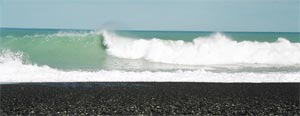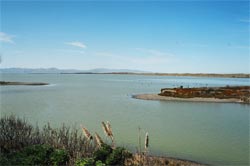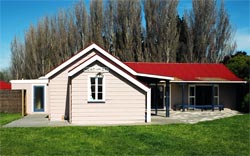This page features extracts from a recorded interview with Cath Brown speaking about Ngāti Moki Marae.
 Cath Brown (Ngāi Tahu) grew up at Taumutu and lived nearby for most of her life. She was a member of the Marae Committee and later held positions as Chair of Te Taumutu Rūnanga and Upoko.
Cath Brown (Ngāi Tahu) grew up at Taumutu and lived nearby for most of her life. She was a member of the Marae Committee and later held positions as Chair of Te Taumutu Rūnanga and Upoko.
An expert Ngāi Tahu weaver and one of the most highly respected Māori artists in New Zealand, Cath led teams of weavers who produced work for Ngāti Moki and many other marae around New Zealand. Her work has been exhibited widely both nationally and internationally. In 2000 she was awarded the Sir Kingi Ihaka Award in recognition of her leadership and contribution to Māori art.
Cath Brown died in 2004 aged 70 a few months after the recordings that feature on this page were made.
Ngāti Moki Marae, Taumutu
Cath Brown talks about her changing role in marae life at Ngāti Moki
Ngāti Moki Marae is located at Taumutu, on the quiet shores of Te Waihora (Lake Ellesmere) at the southern end of Kaitōrete spit. The background roar of the ocean is ever present as waves break onto the narrow spit that separates Te Waihora from the sea.

Taumutu means the end of a ridge, or a high ridge. The name may also be a shortened version of Te Pā o Te Ikamutu - a traditional site in the area.
The swampy environs of Te Waihora including Waiwhio (Irwell River), Waitatari (Harts Creek) and Waikekewai provided the prime environment for tuna (eels), pātiki (flounder), kanakana (lamprey) and waterfowl such as putakitaki (paradise duck). This bounty provided for those living at Taumutu but also afforded them a ready currency for bartering with other hapū all over the South Island.
Cath Brown talks about eeling at Taumutu
The lake as a mahinga kai (food source) has always been a defining aspect of marae life at Taumutu. Ongoing concerns about the preservation of and respect for this resource are central to the work of Te Taumutu Rūnanga today.
The mahinga kai status of Te Waihora
 Historic Pā Sites
Historic Pā Sites
The pā of three heroic Ngāi Tahu tūpuna - Te Rakitamau, Te Ruahikihiki and Moki II - were established at various times at Taumutu. Te Rakitamau’s pā called Hakitai was situated near the traditional opening of Te Waihora to the sea. This pā site has now been reclaimed by the sea. The pā of Te Ruahikihiki called Orariki (the place of chiefs) and Te Pā o Te Ikamutu (the village of the backwash of the fish) were built on a narrow section of land between the edge of Te Waihora and the sea where the Hone Wetere Church now stands.
These pā together with Te Pā o Moki (the pā of Te Ruahikihiki’s son Moki II) were built on strategic and defensible sites that were once surrounded by swampland. Earthwork remains associated with the pā are still visible at Taumutu today. The present day Ngāti Moki marae is built on the site of Te Pā o Moki.
Cath Brown talks about historic Pā at Taumutu
Kāika History
A place of occupation for over 600 years, Taumutu has a longstanding cultural history and has been the site of much archaeological interest for this reason. Borrow pits are visible in the paddock across from the marae. These large depressions in the ground are the result of the removal of earth for use in what are considered to be some of the southernmost kūmara gardens in the South Island.
The kumara gardens at Taumutu
The 19th century saw the kāika at Taumutu embroiled in the turmoil of the Kai Huaka feud 1825-28. The kāika was then doubly threatened by Te Rauparaha’s invasion of the South and the arrival of increasing numbers of European farmers and fishermen.
European immigrants worked to harness the bounty of the lake and develop its surrounding lands into pasture. Māori influence in the area was rapidly eroded culminating in the 1848 Kemp Purchase that saw much of the land at Taumutu passing out of Ngāi Tahu control. Ongoing exploitation of the lakes resources and the European presence led to the population at Taumutu being in serious decline by the end of the 19th century.
Ngāti Moki
 Despite the decreasing population at Taumutu in the late 1800s, a new meeting hall was built and officially opened on 7 May 1891. It replaced an earlier structure that had stood on the same site. The hall was named Moki after the tipuna whose original historic pā had stood on the same ground.
Despite the decreasing population at Taumutu in the late 1800s, a new meeting hall was built and officially opened on 7 May 1891. It replaced an earlier structure that had stood on the same site. The hall was named Moki after the tipuna whose original historic pā had stood on the same ground.
Ngāti Moki has undergone extensive modernisation and additions over the years and so bears little resemblance to its original 1891 form. A dining room wing has been added as well as kitchen and bathroom facilities.

The decoration of the interior has also been a modern addition and can be particularly attributed to the involvement of Taumutu kaumātua, Cath Brown. Taumutu whānau and wānanga groups worked together to create decorative artworks that combine traditional and modern elements illustrating some of Taumutu’s stories. Tukutuku featuring stylised tuna, aua and pātiki grace the walls. Mixed media panels combine weaving, carving and paint.
Cath Brown talks about the decoration of Ngāti Moki Marae

Below Ngāti Moki is the marae wānanga building, Tuteahuka, named after a Ngāi Tahu ancestoral tōhunga and a whare that once stood on Waikirikiri (the Selwyn River). The dining room adjoining Ngāti Moki is named Riki Te Mairaki Ellison in honour of Taumutu kaumātua Riki Ellison. The most recent addition to the collection of marae buildings is an office that was built on to the front of Tuteahuka. A new roofed gateway has also been constructed directly in front of this to provide shelter to manuhiri when they are welcomed to the marae.
The names of the Marae buildings
Awhitu House
 In the late 19th century the M.P. for Southern Māori, H.K. Hori Kerei Taiaroa, moved to Taumutu. Taiaroa had ancestral ties to Taumutu and was an eminent leader and very influential figure in both Māori and Pākehā worlds. Seeking resolution of ‘Te Kerēme’, the Ngāi Tahu Claim was a major part of his life’s work.
In the late 19th century the M.P. for Southern Māori, H.K. Hori Kerei Taiaroa, moved to Taumutu. Taiaroa had ancestral ties to Taumutu and was an eminent leader and very influential figure in both Māori and Pākehā worlds. Seeking resolution of ‘Te Kerēme’, the Ngāi Tahu Claim was a major part of his life’s work.
His family home, Awhitu House, was built at Taumutu in 1878. Awhitu House was the scene of many important gatherings and was to become the residence of successive paramount chiefs of Ngāi Tahu, among them Riki Taiaroa-Ellison. Awhitu house was used as a marae for Taiaroa family gatherings. In April 2003, this whare tawhito (heritage building) tragically burnt to the ground resulting in the loss of not only the building but irreplaceable taonga tukuiho (treasures handed down) housed inside. A memorial garden has been established among the foundations and chimney stacks that remain standing on this historic site.
Hone Wetere Church
Cath Brown talks about the Hone Wetere Church
H. K. Taiaroa was a man of the church and immediately after his move to the Taumutu district he worked with the local Māori and Pākehā communities to raise funds for the building of a whare karakia. The Hone Wetere (John Wesley) Church was subsequently built on the spiritually significant site of the old pā of Te Ruahikihiki. The church was opened in April 1885. It remains closely associated with Ngāti Moki Marae — the marae urupā is situated around the church. The Methodist church are currently in the process of returning Te Hone Wetere Church to Te Taumutu Rūnanga.
Taumutu Today
 Since the 1980s there has been a gradual resurgence in the Māori population at Taumutu, with the marae being frequented for monthly Rūnanga meetings, as well as wānanga, whānau events, school visits and other hui. More people are becoming actively involved in the marae that is a favoured spot for wānanga and educational hui.
Since the 1980s there has been a gradual resurgence in the Māori population at Taumutu, with the marae being frequented for monthly Rūnanga meetings, as well as wānanga, whānau events, school visits and other hui. More people are becoming actively involved in the marae that is a favoured spot for wānanga and educational hui.
Te Taumutu Rūnanga has invested much time and energy in restoration of the riparian margins of the two streams that meet up at, and run past, Ngāti Moki Marae into Te Waihora. A bridge has been constructed and a walkway is planned to link the two old pā sites and provide easy access from the marae to the church and urupā. This work has resulted in the return of many native plant species and it is hoped that the rejuvenation of native bird, fish and insect species will follow.
Links
- Te Taumutu Rūnanga contact details
- Patiki tribute to master weaver and artist Cath Brown, Christchurch City Council Media Release, 21 July 2005
- Miria Simpson, Harakeke Weaving school in Te Ao Hou: outlines the assistance of Cath Brown
- Te Rūnanga o Ngāi Tahu
Sources
- Anon, dedicated to Riki Ellison. ‘The Food Basket of Rakaihautu’: Taumutu, The Past Today: Historic Places in New Zealand, Ed. John Wilson, 1987
- Cath Brown, Interview by Helen Brown. Ellesmere Hospital, Ellesmere. Minidisc recording, 14 April 2004
- Murray Patterson, In sight of the lake & sound of the sea, 1998
- Te Taumutu Rūnanga Society Incorporated

